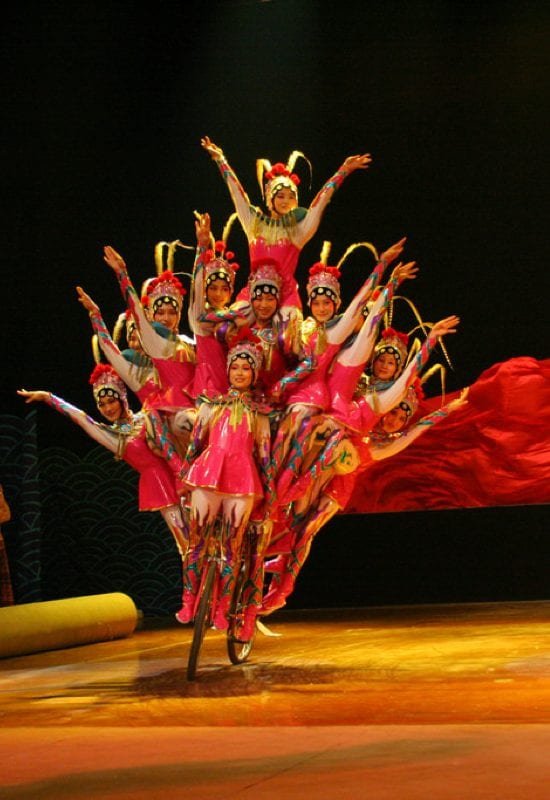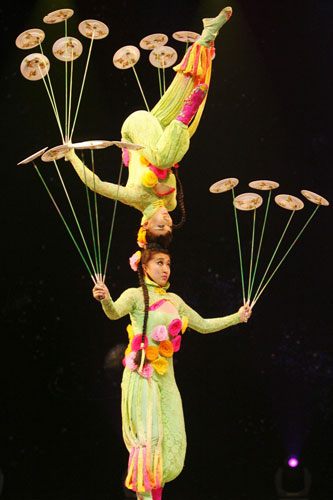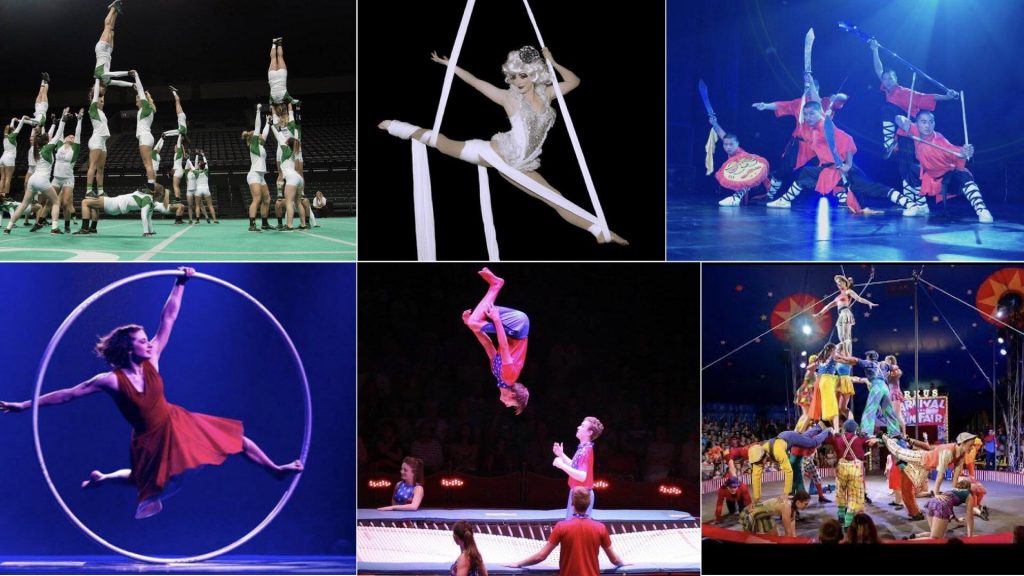What is Acrobatics? A Guide into the Art of Movement
Acrobatics is a captivating display of skill and artistry, where performers use their bodies to create seemingly impossible feats. It's a thrilling spectacle to behold. Many people are curious about this art form, wondering about the risks involved, the training required, and how to find qualified teachers. This guide will address those concerns, providing a comprehensive overview of acrobatics and offering insights into getting started on your own acrobatic journey.
Acrobatics is an exciting form of creative movement, transforming the seemingly impossible into the realm of reality. Acrobats use the human body as their primary instrument, often going head over heels to execute their gravity-defying acts.
Ready to start your acrobatics adventure as an adult? Find a qualified instructor or program near you and begin learning today!
Defining Acrobatics: Beyond the Circus
While often associated with the circus, acrobatics encompasses a far broader range of disciplines. Gymnastics, martial arts, parkour, and even breakdancing all fall under the umbrella of acrobatics. What unites these diverse forms? It is the use of the human body to perform extraordinary feats of strength, flexibility, and coordination. Perhaps this definition sounds a lot like what we call dance. But unlike most traditional dance forms, acrobatics is a distinct collection of physical disciplines. While it may be related to dance, it relies more on a vocabulary of fantastic tricks as its central focus.
As a physically vigorous discipline, the many forms of acrobatics usually take years and years to master and perfect. They have likely been passed down over the years through many generations.
A Journey Through Time: The History of Acrobatics
Ancient Roots
The history of acrobatics stretches back thousands of years. Chinese acrobatics, for instance, dates back to the Xia Dynasty, around 4,000 years ago. Chinese Acrobatics is a renowned, 4,000-year-old tradition dating back to the Xia Dynasty. As an art form founded by the working folk, many of its disciplines used everyday objects like bowls, plates, and chairs as accessories to performers’ incredible physical skill. The ancient Greeks also practiced a form of acrobatics, reflected in their phrase "to walk on tiptoe" or "to climb up." Acrobatics takes its name from the Greek word meaning to walk on tiptoe and to climb up in the air. Indeed, many ancient cultures developed their own unique forms of acrobatic practices, often intertwined with rituals, performances, or martial arts.
The Rise of Circus Acrobatics
During the 18th and 19th centuries, circus acrobatics began to flourish. These daring acts quickly became a central attraction, captivating audiences with their blend of skill, risk, and spectacle. The circus provided a platform for acrobats to showcase their abilities and push the boundaries of the art form.
The Modern Era
Today, acrobatics has found its way into numerous domains. Competitive gymnastics showcases incredible feats of strength and agility on various apparatuses. Cirque du Soleil has revolutionized the art form, blending acrobatics with music, storytelling, and theatrical elements to create breathtaking productions. Newer forms like parkour and tricking have emerged, emphasizing fluidity and creativity in urban environments. Moreover, social media platforms have become a powerful tool for acrobats to share their skills, connect with a global audience, and inspire a new generation of practitioners.

Photo credit: The Ridgefield Playhouse 
Photo credit: Sina.com
The 'Who', 'Why' and 'Where' of Acrobatics
Some people use acrobatics for exercise. Others make a life’s career performing in circus and theatre settings, teaching new students, or even designing stunts for films, television, theme parks, and more. Some may be born into acrobatic families, while others discover it through curiosity later in life.
Acrobatics contribute some of the most amazing acts in the world. But the practice often comes with great danger. Many artists risk it all for the sake of perfecting and presenting their acts. However, if you were to ask them about this, an acrobat will probably tell you it’s worth it.
The Acrobatic Body and Mind: Physical and Mental Demands
Physical Attributes
Acrobatics demands a high level of physical prowess. Strength, particularly in the upper body, core, and legs, is essential for executing many of the movements. Flexibility is equally crucial, allowing for a greater range of motion and the ability to achieve complex poses. Acrobats also need excellent coordination and balance, as well as agility and quick reflexes to react swiftly and maintain control during dynamic movements.
Mental Fortitude
The mental aspect of acrobatics is just as important as the physical. It takes discipline and dedication to train consistently and push through challenges. Acrobats need unwavering focus and concentration to execute intricate maneuvers safely and effectively. Managing fear, especially when performing at heights or attempting risky moves, is a critical skill. Resilience and perseverance are also necessary to overcome setbacks and continue striving for improvement.
The Role of the Coach
A qualified coach plays a vital role in an acrobat's development. A good coach provides expert instruction on proper technique, which is fundamental for both performance and injury prevention. They create a safe training environment and guide students through progressive skill development. Furthermore, a coach serves as a motivator, offering encouragement and support throughout the learning process.
Acrobatic Disciplines: A World of Movement
- Aerial Acrobatics: Also known as aerial arts, this type of acrobatics involves feats of strength, flexibility, and agility performed high above the ground. Aerial acrobats typically climb to heights of thirty feet or more, performing routines on specialized equipment known as an apparatus. Popular apparatuses include the flying trapeze, aerial silks, and aerial straps.
- Circus Acrobatics: This category encompasses a wide array of disciplines, such as chair balancing, contortion, and group acrobatic stunts. While these disciplines can be performed outside the circus, they each have a distinct association with the long-standing traditions of the big top.
- Martial Arts: Popular worldwide, martial arts blend acrobatics, self-defense techniques, and mental discipline. Some of the most popular forms include Karate, Jujutsu, Taekwondo, Tai Chi, and Capoeira, many of which have been featured in television and film.
- Tumbling: Tumbling includes many forms and tricks, such as flips, layouts, and back tucks. It can involve one or more athletes and usually takes place on the floor or ground. Tumbling is also a competitive event in gymnastics.
- Selected Acrobatic Floor Apparatuses
- Handbalancing Canes: These are raised platforms on tall metal or wooden canes of varying heights. Handbalancing canes can allow for a gentle spin in a hand-balancing act or remain static. They offer the performer more height and presence, increasing the risk factor. Many handbalancing canes can be easily disassembled for travel or mounted more permanently on other hard, flat surfaces.
- Cyr Wheel: The practice of the Cyr wheel is perfect for those who love spinning. Artists step inside this giant rotating ring, creating shapes and performing acrobatic feats while controlling its movement.
- Hoops: Hoop artists use multiple hoops, rotating them around their bodies to create a mesmerizing effect. Dance and contortion are often incorporated and set to music, captivating audiences worldwide.
- Trampoline: A trampoline is used for one primary purpose: jumping. Whether employed as a free-standing apparatus or positioned next to a tramp wall, trampoline artistry can be a truly striking spectacle, often involving multiple performers.

Training for Excellence: How Acrobats Develop Their Skills
Building a Foundation
Aspiring acrobats begin by building a solid foundation of physical fitness. This involves general conditioning exercises to improve strength, endurance, and cardiovascular health. Flexibility training is also essential, incorporating both dynamic and static stretching to increase range of motion.
The Importance of Repetition
Repetition is a cornerstone of acrobatic training. Acrobats practice drills and specific movements countless times to develop muscle memory and refine their technique. This constant repetition allows them to execute moves with precision and control, even under pressure.
Safety Practices
Safety is paramount in acrobatics. Spotting, where a trained individual assists and protects the acrobat during practice, is a common practice. Safety mats are used extensively to cushion falls. In some disciplines, harnesses provide an additional layer of protection. A thorough warm-up before each session and a proper cool-down afterward are essential for preventing injuries.
Competitive Acrobatics
Perhaps the best-known competitive acrobatics can be viewed at the Olympic Games, a global spectacle that captivates audiences every two years. Acrobatic sports like ice skating, freestyle skiing, and gymnastics are just a few of the offerings.
In the commercial arena, the TV show America’s Got Talent, which first aired in June 2006, presents many different acts. Over time, it has evolved to showcase the wonders of acrobatics and aerial arts. The show’s competitors are judged by a panel of celebrities in front of a live studio audience. The show also has local versions around the world.
Gymnastics are a highly competitive sport, from the local to the international level. Many young children set their sights on Olympic Gold in childhood. This requires exceptional dedication, long hours of training, and great lengths must be taken to avoid injury.
Dance can be practiced as a recreational activity, for performance, or as part of a competition. Dance competitions can showcase soloists or group numbers, with dancers of all ages represented in various competitive scenes. Lyrical, ballroom, and hip hop dance are all very popular competitive styles.
The Acrobat’s Edge
In a world that’s full of amusements designed to entice and excite, acrobatics stands alone as the most magical offshoot of the performative arts. Making use of the human body to create fantastic forms and spectacles, acrobatics is set apart from other disciplines by trick and tradition.
Above all, acrobats aim to push the limits of the human body and entertain their crowd while doing it. While the masters make it look easy, a true expert devotes years of training to their craft. These athletes often risk everything for their art, giving it all to the stage.
Acrobatics in the Modern World
Cirque du Soleil and Beyond
Cirque du Soleil has profoundly impacted the world of acrobatics. They have transformed it into a highly respected and popular art form. Their productions seamlessly blend acrobatics with music, elaborate costumes, and captivating storytelling, creating a unique and immersive theatrical experience.
Urban Acrobatics
Parkour, freerunning, and tricking are dynamic disciplines that have gained immense popularity. Often practiced in urban environments, these forms of acrobatics emphasize fluidity, creativity, and overcoming obstacles. They have also significantly influenced action sequences in movies and video games.
Social Media's Role
Social media platforms have become a powerful force in the world of acrobatics. They provide a platform for acrobats to share their skills, connect with a global audience, and gain recognition. This widespread exposure is inspiring a new generation of acrobats and contributing to the art form's continued evolution.
The Benefits of Acrobatics: More Than Just a Spectacle
Physical Fitness
Acrobatics offers a fantastic full-body workout. Regular training improves strength, flexibility, balance, and coordination. It also provides cardiovascular benefits, contributing to overall physical fitness.
Mental Well-being
The mental benefits of acrobatics are equally significant. The discipline required for training can help reduce stress and improve focus. Achieving new skills and overcoming challenges boosts confidence and self-esteem. Moreover, the concentration required during practice can have a meditative effect, promoting mental clarity.
Creative Expression
Acrobatics provides a unique avenue for creative expression. Acrobats can develop their own style, choreograph routines, and use their bodies to tell stories or convey emotions. It's a powerful form of artistic communication.
Getting Started with Acrobatics: Your First Steps
Finding a School or Coach
Finding a qualified instructor is crucial for a safe and rewarding experience. Look for gymnastics schools, circus arts programs, or martial arts studios that offer acrobatics classes. Before enrolling, it is a good idea to inquire about the instructors' qualifications, experience, and teaching methods. Don't hesitate to ask questions and ensure the environment is a good fit for you.
What to Expect as a Beginner
Beginner classes typically start with a thorough warm-up toprepare the body for activity. You'll learn fundamental skills, such as basic rolls, handstands, and cartwheels, depending on the specific discipline. Conditioning exercises will help you build the strength and flexibility needed for more advanced moves. Be patient with yourself; progress takes time and consistent effort.
Setting Realistic Goals
It's important to set realistic goals when starting out. Begin with the fundamentals and gradually work your way up to more challenging skills. Listen to your body, and don't push yourself beyond your limits, especially in the early stages. Celebrate your progress, no matter how small, and enjoy the journey of learning and growing.
FAQs
- Is acrobatics dangerous? Like any physical activity, acrobatics carries some inherent risks. However, these risks can be significantly minimized through proper training, qualified instruction, and diligent safety practices.
- Do I need to be flexible to start acrobatics? No, you don't need to be extremely flexible to begin. Flexibility is something that you'll develop over time with consistent training and stretching.
- Am I too old to learn acrobatics? Absolutely not! People of all ages can learn and enjoy acrobatics. There are classes and programs tailored to different age groups and fitness levels.
- Where can I learn acrobatics near me? Search online for "acrobatics classes," "gymnastics schools," "circus schools," or "martial arts studios" in your area. You can also check community centers or adult education programs.
- What should I look for in an acrobatics coach? Look for a coach with experience, relevant certifications (such as those from gymnastics or circus arts organizations), a strong emphasis on safety, and a positive teaching style that encourages and supports students.
- How long does it take to get good at acrobatics? The time it takes to progress in acrobatics varies greatly depending on individual factors, such as natural aptitude, prior experience, training frequency, and dedication. Consistent practice is key to improvement.
- How often should I train in acrobatics? Beginners might start with one or two classes per week. As you progress, you may want to increase the frequency of your training, always considering your body's ability to recover.
- How expensive is it to learn acrobatics? The cost of acrobatics classes can vary depending on the location, the type of facility, and the instructor's experience. Private lessons are generally more expensive than group classes. You might also need to factor in the cost of any specialized equipment.
- What equipment do I need for acrobatics? The equipment needed depends on the specific discipline. Generally, comfortable, form-fitting athletic wear is recommended. Mats are commonly used for safety. Some disciplines may require specialized apparatus, such as aerial silks or a Cyr wheel.
